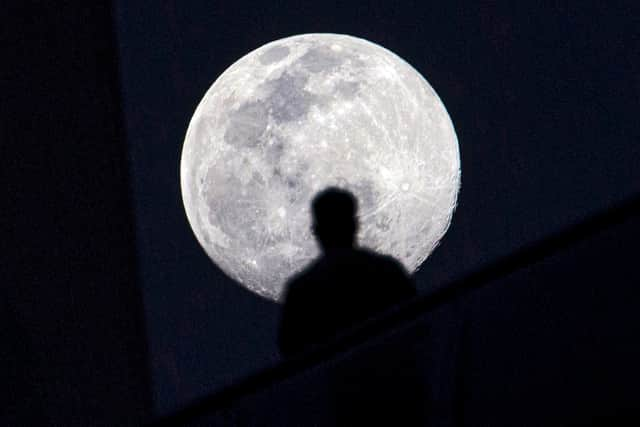Full moon in March 2022: when is the next full moon, how can I see it in UK and why is it called ‘Worm Moon’?
and live on Freeview channel 276
The third full moon of the year, the Worm Moon, will light up UK skies on Friday 18 March as well as appearing on the evening of St Patrick’s Day.
It shares its month with the spring equinox, and is also called the Crow Moon, Crust Moon, Sap Moon, Sugar Moon, or Lenten Moon.
Advertisement
Hide AdAdvertisement
Hide AdHowever its Worm Moon name is most popular in the UK - with it deriving from earthworms.
Here’s everything you need to know about the March full moon - why on earth it is called the Worm Moon, when you can see it in the UK and when the best time to spot it is.
When can I see the Worm Moon 2022?
The Worm Moon can be seen in the evening of St Patrick’s Day, Thursday 17 March 2022 and in the early morning of Friday 18 March 2022 in the UK.


On Thursday 17 March, from London, the Worm Moon will rise from the east-northeast at 5:17pm.
It will set in the west at 6:38am on Friday 18 March.
When is the best time to see the Worm Moon?
Advertisement
Hide AdAdvertisement
Hide AdPeak illumination of the Worm Moon occurs at 7:18am on the morning of Friday (18 March).
As sunrise occurs at 6:18am on Friday you will able to see the Worm Moon low on the horizon, and briefly in the very early morning sky - if the weather allows.
The easiest time to see the Worm Moon at its brightest will be on Thursday evening after the sun has set at 6:08pm.
If you’re unable to see the Worm Moon at its peak, it will also appear full on St Patrick’s Day the night before, as well as the day after.
Advertisement
Hide AdAdvertisement
Hide AdLater on in the month, on 28 March, when the Moon is in its waning crescent phase, you will be able to view it in the company of three planets: Mars, Saturn and Venus.
Venus in particular will appear very bright in the morning sky.
Why is it called the Worm Moon?
As the weather starts to warm at the end of winter, we see a seasonal resurgence of earthworms as they become more active in the soil, and are sometimes seen at the surface.
This is why March’s full moon is named the Worm Moon.
So make sure to look down as well to catch a glimpse of one wriggling on the ground.
It is also a sign that spring is only a few days away.
Advertisement
Hide AdAdvertisement
Hide AdThe names of the full moons come from the 1930s when the Maine Farmer’s Almanac began publishing Native American names for the full Moons in each month of the year.
Since then, these names have widely been adopted around the world.
What are the meanings of the full moon’s other names?
The name, ‘Crow Moon’, derives from crows at this time reacting to all the worms coming to the surface and within easy reach.
After the long, hard winter months, it is a welcome feast for the birds.
Advertisement
Hide AdAdvertisement
Hide AdSap Moon is often used in Canada, as it coincides with the time when maple trees may be tapped for their sap.
Before the winter freeze, maple trees store starch in their trunks, which is converted into sugar - then as the weather warms the sap thaws and the sugar from the sap rises up the tree.
The term Lenten Moon comes from the Old English, or Anglo-Saxon name, and applies if the full Moon occurs during Lent, the Christian preparation for Easter.
When does Easter fall?
Easter Sunday falls on the first Sunday after the full Moon following the spring equinox, and is determined using a lunar calendar called he ecclesiastical calendar,
Advertisement
Hide AdAdvertisement
Hide AdThis year, the spring equinox is on Sunday 20 March, two days after the Worm Moon.
Easter will fall after the next full Moon, which is the Pink Moon on Saturday 16 April.
When is April’s full moon?
The first full Moon of spring will occur on 16 April 2022, the day before Easter.
This full Moon goes by many different names, including Pink Moon, Sprouting Green Moon, Fish Moon and Hare Moon.
A message from the editor:
Advertisement
Hide AdAdvertisement
Hide AdThank you for reading. NationalWorld is a new national news brand, produced by a team of journalists, editors, video producers and designers who live and work across the UK. Find out more about who’s who in the team, and our editorial values. We want to start a community among our readers, so please follow us on Facebook, Twitter and Instagram, and keep the conversation going. You can also sign up to our newsletters and get a curated selection of our best reads to your inbox every day.
Comment Guidelines
National World encourages reader discussion on our stories. User feedback, insights and back-and-forth exchanges add a rich layer of context to reporting. Please review our Community Guidelines before commenting.
